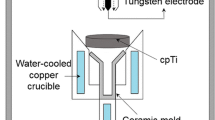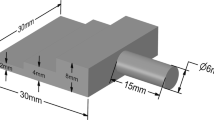Abstract
The surface alpha-case reaction of Ti casting using Ti powder-added investment molds was investigated. During the curing procedure, Ti powders (0, 10, and 50 mass%) were mixed with three types of investment mold materials (Al2O3, ZrSiO4, and ZrO2) to form an interstitial TiO2 phase, which is an alpha-case reaction compound. The microstructure and surface hardness profiles of Ti castings with Ti powder-added investment molds indicated that the alpha-case thickness was significantly reduced from approximately 350 to 50-100 μm, and a remarkable reduction in the maximum micro-Vickers hardness value of the Ti casting surface was also achieved. As observed from the experimental results, the alpha-case reduction mechanism suggested that the phase transformation from TiO2 to TiO not only acts as an effective barrier to O diffusion, but also reduces Al, Si, and Zr concentrations at the casting surface. This reduction might be caused by contact area reduction between the Ti powder-added investment molds and the Ti melts.









Similar content being viewed by others
References
F.H. Froes, M.N. Gungor, and M.A. Imam, Cost-Affordable Titanium—The Component Fabrication Perspective, JOM, 2007, 59, p 28–31
C. Leyens and M. Peters, Titanium and Titanium Alloys, WILEY-VCH, Weinheim, 2003, p 1–35
M.J. Donachie, Jr., Titanium—A Technical Guide, 2nd ed., ASM International, Ohio, 2000, p 55–63
K. Suzuki, The High-Quality Precision Casting of Titanium Alloys, JOM, 1998, 50, p 20–23
S.Y. Sung and Y.J. Kim, Alpha-Case Formation Mechanism on Titanium Investment Castings, Mater. Sci. Eng. A, 2005, 405, p 173–177
R.L. Saha, T.K. Nandy, R.D.K. Misra, and K.T. Jacob, Evaluation of the Reactivity of Titanium with Mould Materials During Casting, Bull. Mater. Sci., 1989, 12, p 481–493
S.Y. Sung, M.G. Kim, and Y.J. Kim, A Study on the Identification of Metal/Mold Reaction Product of Ti Investment Casting, J. Kor. Inst. Met. Mater., 2003, 41, p 557–561 (in Korean)
K.F. Lin and C.C. Lin, Interfacial Reactions between Ti-6Al-4V Alloy and Zirconia Mold During Casting, J. Mater. Sci., 1999, 34, p 5899–5906
C. Frueh, D.R. Poirier, and M.C. Maguire, The Effect of Silica-Containing Binders on the Titanium-Face Coat Reaction, Metall. Mater. Trans. B, 1997, 28, p 919–926
W.J. Boettinger, M.E. Williams, S.R. Coriell, U.R. Kattner, and B.A. Mueller, Alpha Case Thickness Modeling in Investment Castings, Metall. Mater. Trans. B, 2000, 31, p 1419–1427
Z. Liu and G. Welsch, Literature Survey on Diffusivities of Oxygen, Aluminum, and Vanadium in Alpha Titanium, Beta Titanium, and in Rutile, Metall. Trans. A, 1988, 19(4), p 1121–1125
R.L. Saha, T.K. Nandy, R.D.K. Misra, and K.T. Jacob, On the Evaluation of Stability of Rare Earth Oxides as Face Coats for Investment Casting of Titanium, Metall. Trans. B, 1990, 21(6), p 559–566
B.J. Choi, S. Lee, and Y.J. Kim, Influence of TiO2 on Alpha-Case Reaction of Al2O3 Mould in Ti Investment Casting, Mater. Sci. Technol., 2013, 29(12), p 1453–1462
S. Jones and P.M. Marquis, Role of Silica Binders in Investment Casting, Brit. Ceram. Trans., 1995, 94, p 68–73
M.W. Chase, C.A. Davies, J.R. Downey, D.J. Frurip, R.A. McDonald, and A.N. Syverud, JANAF Thermochemical Table, 4th ed., American Chemical Society and American Institute of Physics, New York, 1998, p 154, 1769
Y.W. Chang and C.C. Lin, Compositional Dependence of Phase Formation Mechanisms at the Interface Between Titanium and Calcia-Stabilized Zirconia at 1550°C, J. Am. Ceram. Soc., 2010, 93, p 3893–3901
L.N. Belyanchikov, Thermodynamics of Titanium-Based Melts: II. Oxygen in Liquid Titanium, Russian Metall., 2010, 2010(12), p 1156–1163
J.F. Shackelford and W. Alexander, CRC Materials Science and Engineering Handbook, 3rd ed., CRC Press LLC, New York, 2001, p 1344–1370
Author information
Authors and Affiliations
Corresponding author
Rights and permissions
About this article
Cite this article
Choi, BJ., Lee, S. & Kim, YJ. Alpha-Case Reduction Mechanism of Titanium Powder-Added Investment Molds for Titanium Casting. J. of Materi Eng and Perform 23, 1415–1423 (2014). https://doi.org/10.1007/s11665-013-0859-6
Received:
Revised:
Published:
Issue Date:
DOI: https://doi.org/10.1007/s11665-013-0859-6




